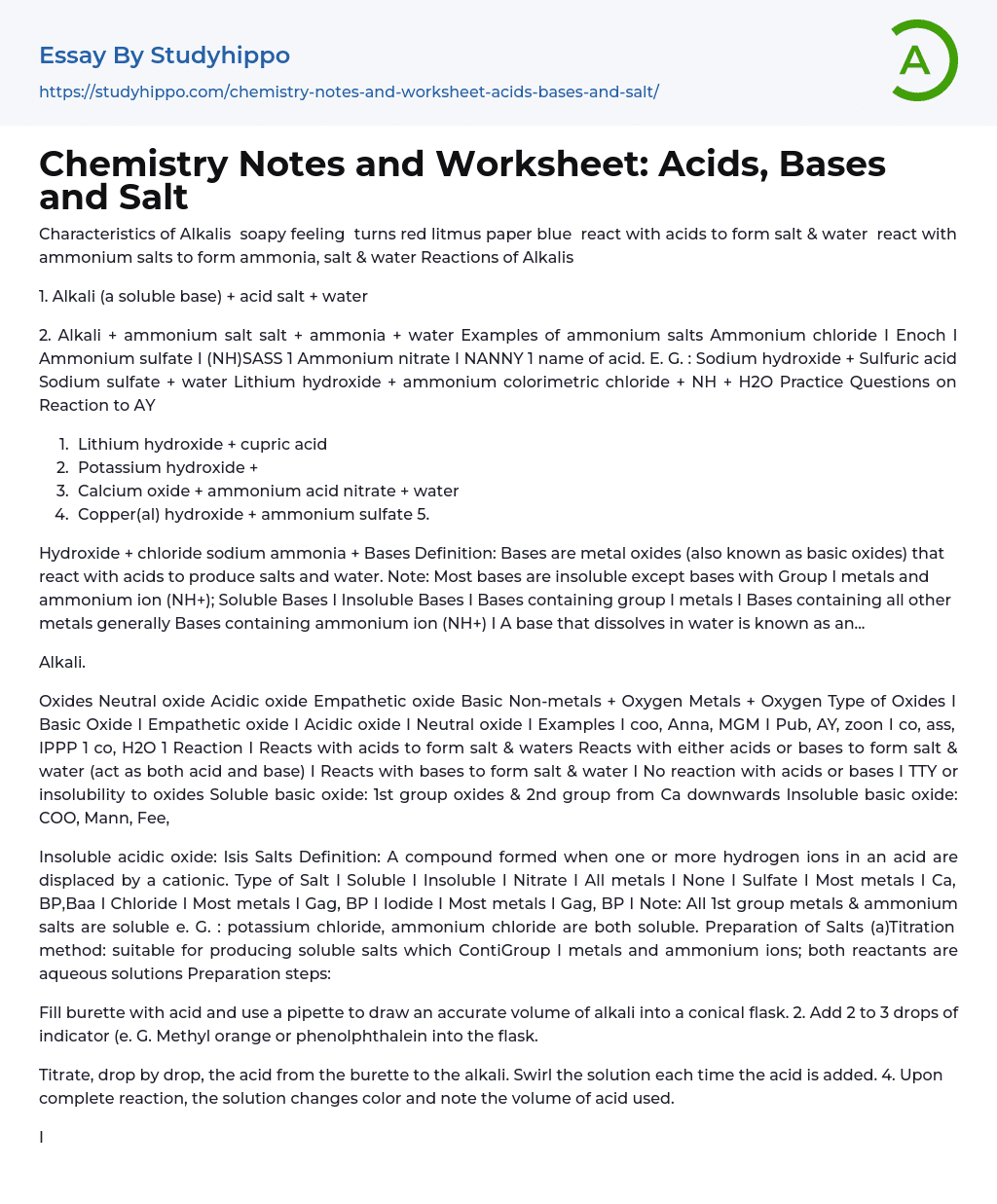

Chemistry Notes and Worksheet: Acids, Bases and Salt Essay Example
Characteristics of Alkalis soapy feeling turns red litmus paper blue react with acids to form salt & water react with ammonium salts to form ammonia, salt & water Reactions of Alkalis
1. Alkali (a soluble base) + acid salt + water
2. Alkali + ammonium salt salt + ammonia + water Examples of ammonium salts Ammonium chloride I Enoch I Ammonium sulfate I (NH)SASS 1 Ammonium nitrate I NANNY 1 name of acid. E. G. : Sodium hydroxide + Sulfuric acid Sodium sulfate + water Lithium hydroxide + ammonium colorimetric chloride + NH + H2O Practice Questions on Reaction to AY
- Lithium hydroxide + cupric acid
- Potassium hydroxide +
- Calcium oxide + ammonium acid nitrate + water
- Copper(al) hydroxide + ammonium sulfate 5.
Hydrox
...ide + chloride sodium ammonia + Bases Definition: Bases are metal oxides (also known as basic oxides) that react with acids to produce salts and water. Note: Most bases are insoluble except bases with Group I metals and ammonium ion (NH+); Soluble Bases I Insoluble Bases I Bases containing group I metals I Bases containing all other metals generally Bases containing ammonium ion (NH+) I A base that dissolves in water is known as an...
Alkali.
Oxides Neutral oxide Acidic oxide Empathetic oxide Basic Non-metals + Oxygen Metals + Oxygen Type of Oxides I Basic Oxide I Empathetic oxide I Acidic oxide I Neutral oxide I Examples I coo, Anna, MGM I Pub, AY, zoon I co, ass, IPPP 1 co, H2O 1 Reaction I Reacts with acids to form salt & waters Reacts with either acids or bases to form salt & water (act as both acid and base) I Reacts with
bases to form salt & water I No reaction with acids or bases I TTY or insolubility to oxides Soluble basic oxide: 1st group oxides & 2nd group from Ca downwards Insoluble basic oxide: COO, Mann, Fee,
Insoluble acidic oxide: Isis Salts Definition: A compound formed when one or more hydrogen ions in an acid are displaced by a cationic. Type of Salt I Soluble I Insoluble I Nitrate I All metals I None I Sulfate I Most metals I Ca, BP,Baa I Chloride I Most metals I Gag, BP I Iodide I Most metals I Gag, BP I Note: All 1st group metals & ammonium salts are soluble e. G. : potassium chloride, ammonium chloride are both soluble. Preparation of Salts (a)Titration method: suitable for producing soluble salts which ContiGroup I metals and ammonium ions; both reactants are aqueous solutions Preparation steps:
Fill burette with acid and use a pipette to draw an accurate volume of alkali into a conical flask. 2. Add 2 to 3 drops of indicator (e. G. Methyl orange or phenolphthalein into the flask.
Titrate, drop by drop, the acid from the burette to the alkali. Swirl the solution each time the acid is added. 4. Upon complete reaction, the solution changes color and note the volume of acid used.
In a separate beaker, repeat the experiment using the exact volume of acid and alkali, only this time without the indicator. A salt solution is formed. 6.
Heat the salt solution until it becomes saturated, and leave it to cool. . Crystals of salt will be formed and let it dry after filtering off excess water. (b) Excess method: suitable for producing soluble
salts when one of the reactants is a solid.
The solid reactant will be added in excess. Pour a fixed volume of acid into a beaker and heat to warm it.
Add solid - metal/metal oxide/metal carbonate/insoluble hydroxide - until there is no further reaction. This indicates that all acid has reacted. 3. Filter the mixture to remove excess unrelated solid. The filtrate is then the salt solution.
Heat filtrate until it becomes saturated and then allow it to cool.
Cooling allows salt crystals to form crystallization). Filter off crystals from the cooled saturated solution and dry them by pressing them between filter paper. (c) Precipitation method: used to produce an insoluble salt.
One of the reactants must be a soluble salt. Soluble salt + soluble salt insoluble salt + soluble salt Soluble salt + acid insoluble salt + acid
- Acid Rain essays
- Acid essays
- Calcium essays
- Carbohydrate essays
- Carbon essays
- Chemical Bond essays
- Chemical Reaction essays
- Chemical reactions essays
- Chromatography essays
- Concentration essays
- Copper essays
- Diffusion essays
- Ethanol essays
- Hydrogen essays
- Organic Chemistry essays
- Osmosis essays
- Periodic Table essays
- Ph essays
- Salt essays
- Sodium essays
- Titration essays
- John Locke essays
- 9/11 essays
- A Good Teacher essays
- A Healthy Diet essays
- A Modest Proposal essays
- A&P essays
- Academic Achievement essays
- Achievement essays
- Achieving goals essays
- Admission essays
- Advantages And Disadvantages Of Internet essays
- Alcoholic drinks essays
- Ammonia essays
- Analytical essays
- Ancient Olympic Games essays
- APA essays
- Arabian Peninsula essays
- Argument essays
- Argumentative essays
- Art essays
- Atlantic Ocean essays
- Auto-ethnography essays
- Autobiography essays
- Ballad essays
- Batman essays
- Binge Eating essays
- Black Power Movement essays
- Blogger essays
- Body Mass Index essays



